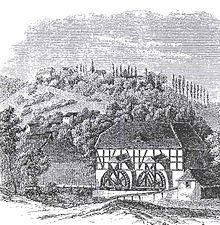Bergsulza
|
Bergsulza
Rural community of Bad Sulza
Coordinates: 51 ° 5 ′ 2 " N , 11 ° 38 ′ 7" E
|
|
|---|---|
| Height : | 186 m |
| Incorporation : | 1923 |
| Postal code : | 99518 |
| Area code : | 036461 |
|
Location of Bergsulza in Bad Sulza
|
|
Mountain Sulza is a district of the rural community of town Bad Sulza in the district Weimarer Land in Thuringia .
geography
Bergsulza is located southeast of Bad Sulza on and on the Saale-Ilm-Platte at 261 meters above sea level in the direction of Schmiedehausen , Lachstedt and Camburg . The state road 2158 leads quite steeply and winding to the plateau. The wooded hills of the Ilm Valley extend to the plateau.
history
The place was first mentioned on April 18, 1063. In the early Middle Ages only the place Sulza existed . Bergsulza later developed on the western foothills of the Herlitzberg to secure the salt production and the transport from the Ilm valley towards Schmiedehausen and Camburg, to meet the Regensburger Straße near Wetzdorf . A castle was built for protection. Instead of this castle, a canon monastery was built by Count Palatine Friedrich II of Saxony in the 11th century . The monastery was located on the site of the well-preserved manor house from the 19th century, which is now the youth hostel .
The place belonged since the middle of the 15th century to the Ernestine Office Roßla , which in 1572 to Saxe-Weimar , 1603 to Saxe-Altenburg , 1672 again to Saxe-Weimar and 1741 to Saxe-Weimar-Eisenach . During the administrative reform of the Grand Duchy of Saxony-Weimar-Eisenach, the place came to the administrative district Weimar II ( administrative district Apolda ) in 1850 and to the state of Thuringia in 1920.
Attractions
The church, now called the Church of St. Wigbert , can be traced back to the church that was consecrated to St. Peter until around 1525. Rather, the church in Dorfsulza was consecrated to St. Wigbert, the rectory from the 17th century and the former manor house are witnesses of the past.
Personalities
- Bernhard Julius Eduard Hergt (1858–1920), teacher and botanist
literature
- Wolf Otto von Tümpling: Historical news about the von Tümplingsche family. Adapted from the posthumous draft of the because Königl. Prussia. General-Majors CM von Schöning. EM Monse, Bautzen 1864, ( digitized version ).
- Georg Judersleben: residents of Sulza before the Reformation (= Bad Sulzaer Heimathefte. 1, ZDB -ID 2290657-5 ). Frauendorff, Bad Sulza 1936.
- Georg Judersleben: The Augustinian Canons' Monastery in Bergsulza (= Bergsulza. Building blocks for the history of our homeland. Vol. 1 = Bad Sulzaer Heimathefte. 7). HMF Heyland, Leutkirch im Allgäu 1993.
- Horst MF Heyland: History of Bergsulza and Dorfsulza (= Bergsulza. Building blocks for the history of our homeland. Vol. 2 = Bad Sulzaer Heimathefte. 11, ZDB -ID 2290657-5 ). HMF Heyland, Leutkirch im Allgäu 1998.
- Thomas Waschke: Sankt Peter zu Bergsulza. History of a canon monastery in Thuringia (= Christian places and communities in the district of Weimarer Land, Altkreis Apolda. 2). Glaux-Verlag Jäger, Jena 1996, ISBN 3-931743-08-X .
Web links
Individual evidence
- ↑ Manfred Stimming : The documents up to the death of Archbishop Adalbert I (1137) (= Mainzer Urkundenbuch. Vol. 1). Self-published by the Hessian Historical Commission, Darmstadt 1932, (306).
- ^ Wolfgang Kahl : First mention of Thuringian towns and villages. A manual. 5th, improved and considerably enlarged edition. Rockstuhl, Bad Langensalza 2010, ISBN 978-3-86777-202-0 , p. 29.
- ↑ Michael Köhler: Thuringian castles and fortified prehistoric and early historical living spaces. Jenzig-Verlag Köhler, Jena 2001, ISBN 3-910141-43-9 , p. 242.
- ^ Andrei Zahn: Patronage in the archdeacon Beatae Mariae Virginis in Erfurt. (Unpublished).





